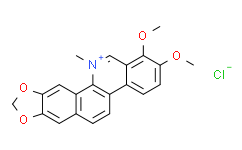| Cas No.: | 3895-92-9 |
| Chemical Name: | Chelerythrine chloride |
| Synonyms: | 1,2-Dimethoxy-12-methyl-[1,3]dioxolo[4',5':4,5]benzo[1,2-c]phenanthridin-12-ium chloride;1,2-Dimethoxy-N-methyl-[1,3]benzodioxolo[5,6-c]phenanthridinium chloride;1,2-dimethoxy-12-methyl-[1,3]benzodioxolo[5,6-c]phenanthridin-12-ium,chloride;1,2-Dimethoxy-12-methyl-[1,3]dioxolo[4',5':4,5]-benzo[1,2-c]phenanthridin-12-ium chloride;CHELERYTHRINE;Chelerythrine (chloride);Chelerythrine Chloride;CHELERYTHRINE CHLORIDE(RG);1,2-dimethoxy-12-methyl[1,3]benzodioxolo[5,6-c]phenanthridiniumchloride;1,2-Dimethoxy-N-methyl(1,3)benzodioxolo(5,6-c)phenanthridinium chloride;Toddaline chloride;Chelerythrinechloride;Chelerythrine hydrochloride;Chelerythrine, chloride;7IC98TZ0PZ;AK115162;C21H18ClNO4;1,2-Dimethoxy-N-methyl-[1,3]-benzodioxolo[5,6c]phenanthridinium |
| SMILES: | [Cl-].O1C([H])([H])OC2=C1C([H])=C1C(=C2[H])C([H])=C([H])C2=C3C([H])=C([H])C(=C(C3=C([H])[N+](C([H])([H])[H])=C21)OC([H])([H])[H])OC([H])([H])[H] |
| Formula: | C21H18ClNO4 |
| M.Wt: | 383.8249 |
| Purity: | >98%, Standard References Grade |
| Sotrage: | 4°C for 1 year, -20°C for more than 2 years |
| Description: | Chelerythrine Chloride is a potent, cell-permeable inhibitor of protein kinase C, with an IC50 of 660 nM. |
| In Vivo: | Chelerythrine displays significant anti-inflammatory effects in experimentally induced mice endotoxic shock model in vivo through inhibition of LPS-induced tumor necrosis factor-alpha (TNF-α) level and nitric oxide (NO) production in serum[2]. Chelerythrine chloride (5 mg/kg/day, i.p.) induces apoptosis of RCC cells without significant toxicity to mice. Chelerythrine Chloride treatment leads to a dose-dependent accumulation of p53[4]. |
| In Vitro: | Chelerythrine inhibits the BclXL-Bak BH3 peptide binding with IC50 of 1.5 μM and displaces Bax, a BH3-containing protein, from BclXL. Mammalian cells treated with Chelerythrine undergoes apoptosis with characteristic features that suggest involvement of the mitochondrial pathway[1]. Chelerythrine treatment inhibits LPS-induced TNF-α level and NO production in LPS-induced murine peritoneal macrophages through selective inhibition of p38 mitogen-activated protein kinase (MAPK) and extracellular signal-regulated protein kinases 1 and 2 (ERK1/2) activation. Moreover, the effects of chelerythrine on NO and cytokine TNF-α production can possibly be explained by the role of p38 MAPK and ERK1/2 in the regulation of inflammatory mediators expression[2]. Chelerythrine shows cytotoxic effect on the human monocytic leukaemia cells with LD50 value of 3.46 μM. Two hours after LPS stimulation, cells influenced by sanguinarine and Chelerythrine significantly decline the CCL-2 expression by a factors of 3.5 and 1.9[3]. Chelerythrine chloride significantly enhances the phosphorylation of ERK1/2 in a dose-dependent manner. In addition, chelerythrine chloride inhibits the phosphorylation of p38[4]. |
| Cell Assay: | Cell viability is evaluated via MTT assay. Cells (2×103 HEK-293 cells/well and 3×103 SW-839 cells/well) in 100 µL medium are seeded into 96-well plates, and incubated for 12 h. Next, the medium in each well is replaced with medium containing various concentrations of Chelerythrine Chloride, and the cells are incubated at 37°C for an additional 24 and 48 h. Subsequently, 20 µL MTT (5 mg/mL) is added to each well. Following an additional incubation at 37°C for 4 h, the supernatant is removed, and 100 µL DMSO is added to each well. The absorbance values (read at 540 nm) are determined using the iMark™ Microplate Absorbance Reader. The data are analyzed using Microplate Manager software (ver. 6.3; 1689520). |
| Animal Administration: | A total of 5×106 SW-839 cells are mixed with Matrigel®, and injected subcutaneously into the flanks of 14 5-week-old male BALB/c nude mice. The mice are maintained in 18×30-cm cages containing three mice each, at a temperature of 22°C using a 12 h light/dark cycle. Food and water is available ad libitum. The mice are randomLy divided into two groups (n=7). As previously described, the mice are administrated with chelerythrine chloride at a dose of 5 mg/kg/day via intraperitoneal injection for 5 weeks, with the first injection of chelerythrine chlorideurring 24 h after injection with the SW-839 cells. The control mice are administered with the same volume of PBS containing 1% DMSO. The volume and weight of the mouse tumors are measured once a week. All the mice are sacrificed 36 days subsequent to inoculation of the cancer cells, when the tumors are resected. |
| References: | [1]. Chan, et al. Identification of chelerythrine as an inhibitor of BclXL function. J Biol Chem. 2003 Jun 6;278(23):20453-6. [2]. Li W, et al. Effect of Chelerythrine Against Endotoxic Shock in Mice and Its Modulation of Inflammatory Mediators in Peritoneal Macrophages Through the Modulation of Mitogen-Activated Protein Kinase (MAPK) Pathway. Inflammation. 2012 Jul 24. [3]. Pencikova K, et al. Investigation of sanguinarine and chelerythrine effects on LPS-induced inflammatory gene expression in THP-1 cell line. Phytomedicine. 2012 Jul 15;19(10):890-5. Epub 2012 May 14. [4]. Chen XM, et al. Chelerythrine chloride induces apoptosis in renal cancer HEK-293 and SW-839 cell lines. Oncol Lett. 2016 Jun;11(6):3917-3924 [5]. Herbert JM, et al. Chelerythrine is a potent and specific inhibitor of protein kinase C. Biochem Biophys Res Commun. 1990 Nov 15;172(3):993-9. |

 DC Chemicals' products qualify for U.S. tariff exemptions. We guarantee no price increases due to customs duties and maintain stable supply, continuing to deliver reliable research solutions to our American clients.
DC Chemicals' products qualify for U.S. tariff exemptions. We guarantee no price increases due to customs duties and maintain stable supply, continuing to deliver reliable research solutions to our American clients.





















